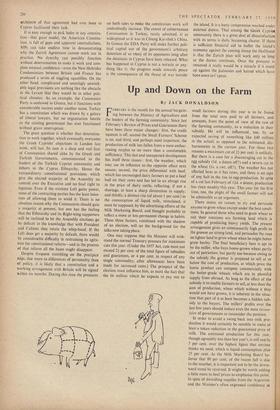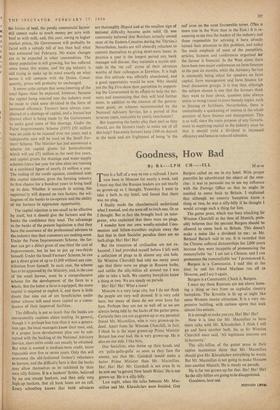Up and Down on the Farm
By JACK DONALDSON EBRUARY is the month for the annual bargain- ing between the Ministry of Agriculture and the leaders of the farming community. Since last February's Review of Prices and Guarantees there have been three major changes: first, the credit squeeze is off, second the Small Farmers' Scheme is on, and third, and perhaps most important, the production of milk has fallen from a most embar- rassing surplus to no more than a comfortable sufficiency. This last and unexpected development has itself three causes: first, the weather, which may use its influence to the opposite effect next season; second, the price differential with beef, which has encouraged dairy farmers to put a beef bull on their cows and has led to an abrupt rise in the price of dairy cattle, reflecting, if not a shortage, at least a sharp diminution in supply; and thirdly, a distinct rise (of about 1 per cent.) in the consumption of liquid milk, stimulated, it must be supposed, by the advertising efforts of the Milk Marketing Board, and thought probably to reflect a more or less permanent change in habits. These three factors, combined with the shadow of an election, will set the background for the talks now taking place.
One may suppose that the Minister will with- stand the normal Treasury pressure for maximum cuts this year. (Under the 1957 Act, cuts must,not exceed 2+ per cent. of the total figure of subsidies and guarantees, or 4 per cent. in respect of any single commodity, after allowances have been made for increased costs.) The prospect of the election must influence him, as must the fact that the £6 million which he expects to pay out to small farmers during this year is to be found from the total sum paid to all farmers, and amounts, from the point of view of the rest of the farming community, to a reduction in their subsidy. He will be influenced, too, by an expected saving of something like £40 million in the actual, as opposed to the estimated, dis- bursements in the current year. For these two reasons a maximum cut of 2+ per cent. is unlikely. But there is a case for a discouraging cut in the egg subsidy (Id. a dozen off?) and a severe cut in the wheat (Is. a cwt. off?). The weather has not affected hens as it has cows, and there is no sign of any halt in the rise in egg-production. In spite of a cut last February of led. a dozen, production has risen steadily this year. This year for the first time, too, the plight of the small farmer will not be admissible as an argument. There seems no reason to try and persuade anyone to grow wheat except under the best condi- tions. In general those who need to grow wheat to suit their rotations are farming land which is capable of producing heavy yields. The present arrangement gives an unnecessarily high profit to the grower on strong land, and persuades the man on lighter land to grow wheat when he might better grow barley. The final beneficiary here is apt to be the miller, who buys home-grown wheat partly out of patriotism, but partly too because owing to the subsidy the grower is prepared to sell at or below the cost of production, at which price the home product can compete commercially with the better-grade wheats which are in plentiful supply from abroad. As long as the effect of the subsidy is to enable farmers to sell, at less than the cost of production, wheat which without it they would not have grown, it is inherent in the situa- tion that part of it at least becomes a hidden sub- sidy to the buyers. The millers' profits over the last few years should induce even the most laisser- faire of governments to reconsider the position.
In order to avoid a swing back into milk pro- duction it would certainly be sensible to make at least a token reduction in the guaranteed price of milk. The estimated production for this year, though agreeably less than last year's, is still nearly 5 per cent. over the highest figure that anyone thinks we need, which is liquid consumption plus 25 per cent. As the M ilk Marketing Board be- lieves that 80 per cent. of the recent fall is due to the weather, it is important not to let the down- ward trend be reversed. It might be worth adding a little more to beef prices to emphasise this point. In spite of dwindling supplies from the Argentine and the Minister's often expressed confidence in the future of beef, the purely commercial farmer still cannot make as much money per acre with beef as with milk, and, this year, owing to higher market prices, the Government will probably be faced with a subsidy bill of less than half what was estimated last February. No major changes are to be expected in other commodities. The sheep population is still growing, but has suffered some losses this winter, and the pig industry is still trying to make up its mind exactly on what terms it will compete with the Danes. Conse- quently, prices will probably be unchanged.
It seems quite certain that some.lowering of the total figure must be expected, however, • because the capital being injected into the industry must be made to yield some dividend in the form Of increased efficiency. Farmers have always com- plained of a shortage of capital, and 'a limited but distinct effort is being made by the Government to make good some of this shortage. Under the Farm Improvements Scheme (1957) £50 million was set aside to be injected over ten years, and a comparable sum will be used on the Small Far- mers' Scheme. The Minister has just announced a scheme for capital grants for horticulturists which will use £71 million in the next five years, and capital grants for drainage and water-supply schemes (since last year for silos also) are running at a combined figure of nearly £4 million a year. The ending of the credit squeeze, combined with this capital injection, gives the farming industry its first chance for a hundred years to bring itself up to date. Whether it succeeds in seizing this opportun!ty will depend on two factors, the wil- lingness of the banks to co-operate and the ability of the farmers to appreciate opportunity.
The capital injection is too small to be effective by itself, but it should give the farmers and the banks the confidence they need. The advantage to the banks of the present legislation is that they have the assurance of the professional advisers to the industry that their customers are making sense. Under the Farm Improvements Scheme, the far- mer can get a direct grant of one-third the cost of improvements, but he has to put up two-thirds himself. Under the Small Farmers' Scheme, he can get a direct grant of up to £1,000 without any con- tribution from himself. In each case, the scheme has to be approved by the Ministry, and, in the case of the small farmer, must be a comprehensive scheme for the development of the farm as a whole. But the better a farm is equipped, the more capital is required to exploit it; and there is little doubt that nine out of ten beneficiaries under either scheme will need more capital as a conse- quence of their improved facilities.
The difficulty is not so much that the banks are unreasonably cautious about lending. In general, though it is perhaps less true than it was a genera- tion ago, the local managers know their men, and, if a proper farm development plan can be sub- mitted with the backing of the National Advisory Service, short-term credit can usually be obtained. But what is wanted is medium-term credit, loans repayable over five or seven years. Only this will overcome, the old-fashioned farmer's reluctance to borrow, and the difficulty'here is that.the banks may allow themselves to be inhibited by their own silly fictions. It is a bankers' fictibn, believed by no one except bankers, and then only very high-up bankers, that all bank loans are on call. Every schoolboy knows that bank advances are thoroughly illiquid and at the smallest sign of national difficulty become quite solid. (It was commonly believed that Barclays actually owned most of the Eastern Counties during the Thirties.) Nevertheless, banks are still absurdly reluctant to commit themselves to giving short-term loans; in practice a year is the longest period any bank manager will discuss; they maintain a mystic atti- tude to the 'on call' status of their advances worthy of their colleagues in Erewhon. It is high time this attitude was officially abandoned, and a good opportunity would be now. Why should not the Big Five show their patriotism by support- ing the Government in its efforts to help the far- mers and announcing that they will lend further sums, in addition to the amount of the govern- ment grant, on schemes recommended by the National Advisory Service, for a period of five to seven years, repayable by yearly instalments?
But supposing the banks play. their part as they should, are the farmers ready to make use of all this help? Too many farmers keep £500 on deposit at the bank and are frightened of being 'in the red' even on the most favourable terms. ('This is more true in the West than in the East.) It is re- assuring to see that the leaders of the industry and those responsible for advising it have already turned their attention to this problem, and today the main emphasis of most of the pamphlets, articles, lectures and conferences organised for the farmer is financial. In the West alone there have been two major conferences on farm finances in the past six months, while the Advisory Service is constantly being asked for speakers on farm capital, farm management and farm finance for local discussion groups. It is true that, although the subject chosen is one that the farmers think they want to hear, about, question time always seems to swing round to more homely topics, such as fencing or fertilisers. Nevertheless, there is undoubtedly a quickening of interest in the whole question of farm finance and management. This is as well, since the main purpose of any Govern- ment in supplying capital to the industry must be that it should yield a dividend in increased efficiency and hence in reduced subsidies.



































 Previous page
Previous page